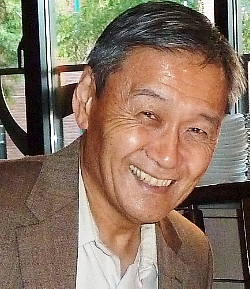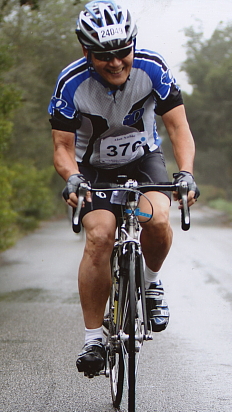Alan's Story

Alan was 61 when he was diagnosed with leiomyosarcoma of the pelvic cavity. His treatments included surgery, radiation therapy and chemotherapy.
In 2006, a leiomyosarcoma (LMS) tumor was discovered in my pelvic cavity. This tumor was identified as LMS six weeks after I had first experienced symptoms. The first signs were frequent urination followed by a rise in blood pressure. Initially, my doctor suspected that these symptoms were likely caused by an enlarged prostate, a common symptom amongst men over 60 years of age. After four weeks, when I did not respond to the prostate and blood pressure medications that were prescribed, my doctor suggested that I undergo a sonogram.
The sonogram found that there was a large mass that was pushing against my kidney and bladder. A biopsy was ordered and after a long wait a diagnosis of a leiomyosarcoma was made. The urologist who reviewed the biopsy I spoke to said that in his 20 years of practice that this was the first LMS that he had diagnosed and that he was reading about LMS to obtain more information.
Prior to the discovery of my LMS, I was making plans for retirement after 35 years of serving as a university administrator and faculty member. My planned retirement was to enable me to initiate a new project that I had been envisioning for years, a public charter middle school serving the downtown Los Angeles area. After learning about the bleak prospects I was confronting with my cancer, I was forced to drop this project and opted for an early retirement.
What I remember most about the discovery of my LMS was the somewhat clinical manner in which I approached my surgery and treatments. I tried to learn as much as I could about LMS to try to prepare myself for the challenge that lay ahead. Fortunately, my discovery of the LMS listserve and the www.leiomyosarcoma.info website provided me with valuable support and guidance. Through my search I was able to make contact with Dr. Doreen Kossove ("Dr. Dee," as she was known to us who have been battling LMS for years). While battling Stage IV LMS herself, Dr. Dee contacted me and provided me with valuable insights and information on the choices in the road that lay ahead for me. My remembrance of the time spent with Dr. Dee, and the subsequent meetings and correspondence with other LMS survivors, are fond ones that have been so meaningful to me.
What I also remember about my reactions to the discovery of LMS was my sense of peace regarding where I was in life. I was thankful for a wonderful life with a great family, good friends, a fulfilling career, and active involvement in community activities. As my children were both adults with families and well-established in their careers and my wife was strong and active, I felt that I could move forward in good spirits no matter how many days, months, or years lay ahead for me.
Treatment
Following my LMS diagnosis I had to wait four weeks before surgery was scheduled at Kaiser in Los Angeles. It took two weeks to schedule a consultation appointment with the surgeon and then another two weeks to schedule the surgery. During this four week period the tumor continued to grow and I was experiencing more pronounced symptoms. After a nine hour surgery, a large (19 cm wide) mass was removed. Fortunately, the tumor did not appear to be attached to any organs but a safe margin could not be obtained as the tumor was adjacent to my right pelvic sidewall. The pathology of the tumor revealed the mass to be high grade.
After my initial surgery to resect the LMS tumor, I had an eight week recuperation period. During that time, I reviewed my options and decided to undergo both radiation (IMRT) and chemotherapy treatments (Gemzar and Taxotere). While not easy decisions, I felt both radiation and chemo were in order as the primary tumor was lodged next to my pelvic sidewall so it may possibly have metastasized. I was extremely fortunate to be located near to a major sarcoma center (Cedars Sinai Sarcoma Center) and treated by a knowledgeable sarcoma care team led by Dr. Charles Forscher. Upon consultation with Dr. Forscher, I decided to undergo radiation treatment to focus on the area adjacent to the pelvic side wall. IMRT was used to focus radiation and minimize the level of general radiation exposure to the pelvic cavity. As I completed my radiation treatments, I began chemotherapy. Gemzar and Taxotere (Gem/Tax) were selected. My chemotherapy was completed in six months.
Fortunately, the side effects of both the radiation and chemo were minimal. The radiation was fine with no burning and, to date, I have no lasting effects from the radiation. The chemo was also tolerated well. As the treatments advanced I began to experience extreme fatigue and shortness of breath but was generally comfortable during the treatment. Exceptions were occasional diarrhea and constipation.
Recurrence and Recovery
After 4 ½ years of having No Evidence of Disease (NED), I experienced a local recurrence of my LMS in my pelvic cavity in September 2011. Fortunately, this recurrence was discovered early enough due to my 6 month CT scan schedule. The tumor was surgically removed with no additional treatments other than regular CT scans to identify any additional recurrences.
 My recovery from my initial surgery and treatments and my recurrence has gone extremely well. I attest some of my relatively smooth recuperations from the fact that I have always been physically active. Prior to my LMS and now I remain active in cycling and tennis. I have maintained a regular schedule of physical activity since my recurrence and try to maintain this as it is likely that there may be some recurrences in the future. After my recurrence, I now drink a daily blend of kale, spinach, carrots, and juice as a preventative measure. I have also undergone Chinese herbal detoxification.
My recovery from my initial surgery and treatments and my recurrence has gone extremely well. I attest some of my relatively smooth recuperations from the fact that I have always been physically active. Prior to my LMS and now I remain active in cycling and tennis. I have maintained a regular schedule of physical activity since my recurrence and try to maintain this as it is likely that there may be some recurrences in the future. After my recurrence, I now drink a daily blend of kale, spinach, carrots, and juice as a preventative measure. I have also undergone Chinese herbal detoxification.
Life Now
I am enjoying retirement and continuing to do the things that are important to me. I try to maintain an active life that balances family/friends, with community service and maintaining a good diet and fitness regimen. I stay connected to the sarcoma community by actively reading the LMS listserve, supporting the Liddy Shriver Sarcoma Initiative and also participating in events sponsored by the Sarcoma Alliance.
Thoughts for New Patients
I have advised some friends I have met who are battling sarcomas and other rare cancers. My advice mirrors what the LMS listserve and the Liddy Shriver Sarcoma Initiative website stress: Be seen at a cancer center that specializes in sarcomas. Educate and empower yourself to be a full partner in the development of a treatment plan. Engage and seek the support of others who are fighting similar battles. Finally, I would stress the importance of addressing the emotional needs of family and friends who are providing care and support. Emotionally and psychologically dealing with LMS has been much harder on my wife than it has been on me. I think if our roles were reversed that I, too, would have a much harder time.
Leave a Facebook Comment
Copyright © October 2012 Liddy Shriver Sarcoma Initiative.
